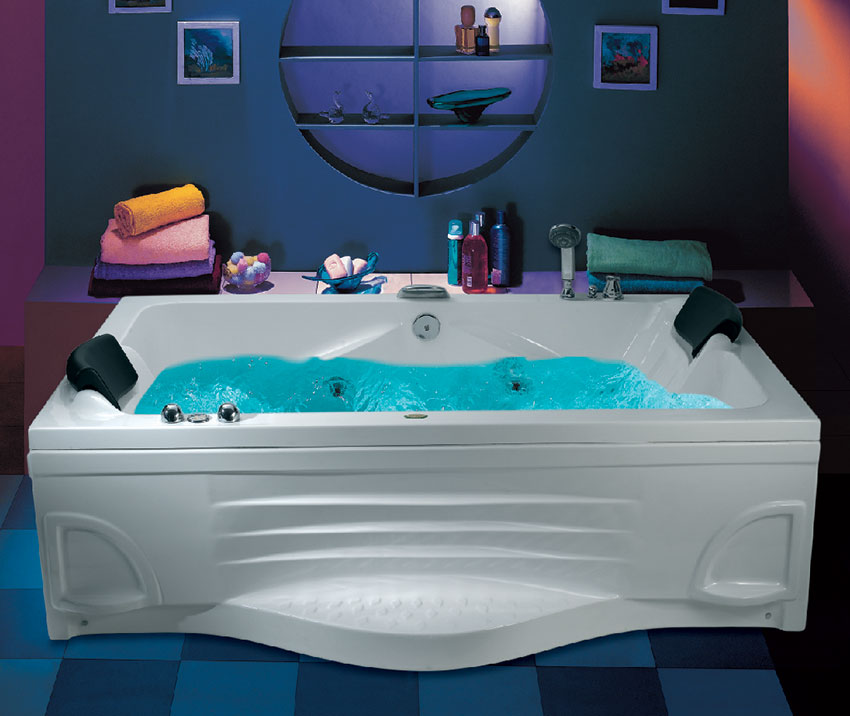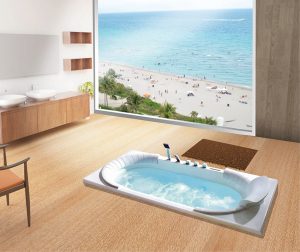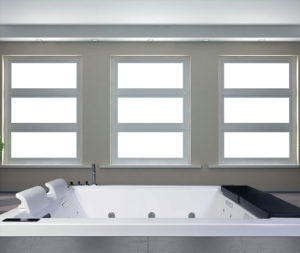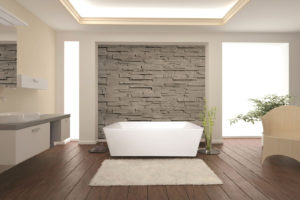Freestanding tubs have been a symbol of luxury and relaxation for centuries. These standalone bathtubs have evolved from their humble beginnings to become stunning centerpieces in modern bathrooms. Among the various shapes available, round freestanding tubs have gained immense popularity in recent years. They offer a perfect blend of style and comfort, fitting seamlessly into bathrooms of all sizes and designs.
Round freestanding tubs come in a wide range of styles, from classic clawfoot designs to sleek, contemporary models. This variety makes them suitable for different tastes and bathroom aesthetics. Whether you’re aiming for a vintage-inspired look or a cutting-edge modern vibe, there’s a round freestanding tub that will fit your vision.
Let’s explore the world of round freestanding tubs, from timeless classics to modern marvels, and discover how these versatile fixtures can transform your bathroom into a personal oasis.
Classic Designs: A Nod to Tradition
When we think of classic round freestanding tubs, the first image that often comes to mind is the iconic clawfoot tub. These tubs have their roots in Victorian-era design and continue to be a popular choice for those seeking a touch of vintage elegance in their bathrooms. Traditional clawfoot tubs are typically made of cast iron with a smooth, glossy porcelain enamel finish. This combination of materials not only looks beautiful but also retains heat well, ensuring a long, warm soak.
One of the defining features of clawfoot tubs is, of course, their feet. These ornate supports come in various designs, with the most common being the lion paw and the ball-and-claw. The feet aren’t just decorative; they also elevate the tub off the floor, adding to its grandeur and making it easier to clean underneath. For those who love the classic look but want something a bit different, there are modern interpretations of clawfoot tubs that feature simpler, more streamlined feet designs.
Another classic design in the world of round freestanding tubs is the slipper tub. These tubs are characterized by their elevated back, which provides extra support and comfort for the bather. Slipper tubs come in two main varieties: single slipper and double slipper. Single slipper tubs have one raised end, while double slipper tubs have both ends raised, allowing two people to enjoy a comfortable recline from either end of the tub.
For those who prefer a more solid look, pedestal tubs offer a classic alternative to clawfoot designs. Instead of separate feet, these tubs sit on a solid base. This base can be simple and understated or decorated with vintage-inspired patterns and details. Pedestal tubs provide a sense of stability and can be an excellent choice for bathrooms with limited floor space.
These classic designs bring a timeless charm to any bathroom. They work particularly well in traditional or vintage-inspired spaces but can also create an interesting contrast in more modern settings. The key to incorporating these classic tubs into your bathroom design is to balance their ornate features with complementary fixtures and decor that enhance, rather than compete with, their inherent beauty.
Transitional Styles: Bridging the Gap
As bathroom design trends have evolved, so too have freestanding tubs. Transitional styles offer a perfect middle ground between classic and contemporary designs, appealing to those who appreciate traditional elements but desire a more updated look. These tubs take inspiration from classic designs but incorporate modern twists to create unique, versatile pieces that can adapt to various bathroom styles.
One popular transitional style is the updated classic design. These tubs maintain the overall shape and feel of traditional clawfoot or slipper tubs but feature simplified lines and less ornate details. For example, you might see a tub with the classic oval shape of a clawfoot model, but with straighter, more geometric feet instead of the traditional ornate designs. These updated classics offer a nod to the past while fitting comfortably into more modern spaces.
Another trend in transitional round freestanding tubs is the use of hybrid materials. Manufacturers are combining traditional looks with modern materials to create tubs that offer the best of both worlds. You might find an acrylic tub body paired with metallic feet, giving the appearance of a classic clawfoot tub but with the lightweight properties and easy maintenance of acrylic. Similarly, composite materials are being used to mimic the look of traditional materials like cast iron, providing the classic aesthetic without the hefty weight.
Transitional styles often feature subtle curves and soft lines, creating a gentle, inviting appearance. Egg-shaped tubs are a popular choice in this category, offering a modern take on the classic oval shape. These tubs typically have one end slightly higher than the other, providing comfortable back support similar to a slipper tub, but with a more contemporary silhouette. Tubs with gently sloping sides are another common feature in transitional designs, softening the overall look of the bathroom while maintaining a clean, uncluttered aesthetic.
The beauty of transitional styles lies in their versatility. They can easily blend into a wide range of bathroom designs, from those with a slight traditional lean to more contemporary spaces. This adaptability makes them an excellent choice for homeowners who want to update their bathroom without committing to a fully modern look, or for those who enjoy mixing design elements from different eras.
Contemporary Designs: Embracing Modern Aesthetics
As we move into the realm of contemporary design, round freestanding tubs take on a whole new persona. These modern tubs are all about clean lines, innovative materials, and cutting-edge features. They’re perfect for those who want their bathroom to feel like a luxurious spa retreat or a showcase of modern design.
Minimalist aesthetics are a hallmark of contemporary round freestanding tubs. These designs strip away any unnecessary ornamentation, focusing instead on pure, simple forms. You’ll often see tubs with perfectly circular shapes or gentle, continuous curves that create a sense of flow and serenity in the bathroom. The emphasis is on letting the form of the tub speak for itself, without any distracting elements.
Many contemporary tubs feature matte finishes and neutral colors, which add to their modern appeal. White is still a popular choice, but you’ll also find tubs in shades of gray, black, and even concrete-like finishes. These neutral tones allow the tub to blend seamlessly with a variety of bathroom color schemes while still maintaining its status as a focal point.
For those who want something truly unique, sculptural forms are becoming increasingly popular in contemporary tub design. These tubs take inspiration from nature or abstract art, resulting in organic, asymmetrical shapes that double as functional bathtubs and works of art. You might see tubs that mimic the shape of a water-worn pebble or others that seem to defy gravity with their unconventional forms.
But contemporary round freestanding tubs aren’t just about looks – they often come packed with high-tech features that enhance the bathing experience. Built-in LED lighting is a popular option, allowing you to set the mood for a relaxing soak with color-changing lights. Some tubs even incorporate hydrotherapy jets, bringing the spa experience right into your home bathroom.
For the tech-savvy homeowner, smart technology is making its way into tub design as well. You might find tubs with digital controls for temperature and filling, or even voice-activated features that let you start your bath with a simple command.
These contemporary designs are perfect for modern and minimalist bathrooms, but they can also serve as an eye-catching contrast in more traditional spaces. The key to incorporating a contemporary round freestanding tub into your bathroom is to let it take center stage – keep the surrounding elements simple and complementary to really allow the tub’s design to shine.
Material Innovations: Expanding Design Possibilities
The world of round freestanding tubs has seen exciting developments in materials, opening up new possibilities for both aesthetics and functionality. These material innovations allow homeowners to choose tubs that not only look stunning but also offer practical benefits like improved durability and heat retention.
Stone and stone resin tubs have gained popularity in recent years. Natural stone options like marble and granite bring a touch of luxury and uniqueness to the bathroom, with each tub featuring its own distinct pattern and coloration. However, natural stone can be quite heavy and expensive. Enter stone resin – a material that mimics the look and feel of natural stone but is lighter and more affordable. Stone resin tubs offer excellent heat retention properties, keeping your bathwater warmer for longer. They’re also highly durable and resistant to scratches and stains, making them a practical choice for busy households.
Metal tubs are another exciting option in the world of round freestanding tubs. Copper, brass, and stainless steel tubs make bold statements in any bathroom. Copper tubs, in particular, have gained popularity not just for their striking appearance but also for their natural antimicrobial properties. These tubs develop a beautiful patina over time, adding character and depth to their appearance. For those who prefer a more polished look, hammered metal textures offer visual interest while maintaining a sleek overall appearance.
Wooden tubs might seem like an unusual choice, but they’re gaining traction among homeowners looking for a natural, spa-like feel in their bathrooms. Teak, cedar, and oak are popular choices for wooden tubs due to their natural water-resistant properties. These tubs bring warmth and organic texture to the bathroom, creating a serene, nature-inspired atmosphere. They’re also an eco-friendly option, especially when sourced from sustainably managed forests.
Each of these materials brings its own unique characteristics to round freestanding tubs, allowing for a wide range of design possibilities. When choosing a material for your tub, consider not only the aesthetic appeal but also practical factors like weight (especially important for upper-floor bathrooms), heat retention, durability, and maintenance requirements.
The innovation in materials has truly expanded the design possibilities for round freestanding tubs. Whether you’re drawn to the timeless elegance of stone, the bold statement of metal, or the natural warmth of wood, there’s a material that can bring your bathroom vision to life while meeting your practical needs.
Color and Finish Trends: Making a Statement
Gone are the days when bathtubs were limited to basic white. Today’s round freestanding tubs come in a wide array of colors and finishes, allowing homeowners to make bold design statements or create subtle, sophisticated looks in their bathrooms.
Bold and vibrant hues are making a splash in bathroom design, and round freestanding tubs are no exception. Jewel tones like emerald green, sapphire blue, and ruby red are popular choices for those who want their tub to be a true focal point. These rich colors can add depth and personality to a bathroom, especially when set against neutral walls and flooring. For a really striking look, some tubs feature contrasting exteriors and interiors – imagine a glossy black exterior with a bright white interior, or a matte charcoal exterior with a shimmering gold interior.
Metallic finishes are another trend that’s gaining momentum in the world of round freestanding tubs. Gold, rose gold, and brushed nickel finishes add a touch of glamour and luxury to the bathroom. These metallic tones can warm up a cool color scheme or add a bit of sparkle to a neutral palette. For those who want something truly eye-catching, pearlescent and iridescent finishes create a magical, color-changing effect that shifts depending on the lighting and viewing angle.
Textured surfaces are also becoming more popular, adding visual and tactile interest to round freestanding tubs. Stone-like textures can give a tub a natural, organic feel, perfect for creating a spa-like atmosphere in your bathroom. Other textured finishes might mimic the look of linen or even concrete, providing a unique sensory experience that goes beyond the visual.
When choosing a color or finish for your round freestanding tub, it’s important to consider how it will fit into your overall bathroom design. A boldly colored tub can serve as an exciting focal point, but it should be balanced with more subdued elements in the rest of the space. Metallic finishes can add a touch of luxury, but be careful not to overdo it – too much shine can be overwhelming in a small space.
Remember, the color and finish of your tub can greatly impact the mood and style of your bathroom. A crisp white tub might create a clean, classic look, while a deep blue tub could evoke a sense of calm and serenity. A copper tub with a developing patina could add character and warmth, while a sleek black tub might lend a modern, sophisticated air to the space.
Ultimately, the choice of color and finish for your round freestanding tub is a personal one. It’s an opportunity to express your style and create a bathroom that truly reflects your personality. Whether you opt for a bold, attention-grabbing hue or a subtle, textured finish, your choice will play a significant role in shaping the overall look and feel of your bathroom.
Placement and Styling: Creating the Perfect Bathroom Oasis
The placement and styling of your round freestanding tub can make a big difference in how it looks and feels in your bathroom. With the right approach, you can turn your tub into a stunning focal point that enhances the entire space.
Many homeowners choose to position their round freestanding tub as the centerpiece of the bathroom. This works especially well in spacious bathrooms where the tub can truly take center stage. Placing the tub in the middle of the room or in front of a window can create a dramatic effect. If you have a view, positioning the tub to take advantage of it can make your bathing experience even more luxurious.
To really showcase your tub, consider the space around it. Leaving some open floor space around the tub can help it stand out and make the room feel more spacious. You might also consider adding a beautiful rug or a small side table near the tub for a touch of comfort and convenience.
Pairing your round freestanding tub with the right fixtures and accessories can enhance its impact. Freestanding faucets are a popular choice for these tubs, as they add to the standalone look. These faucets come in a variety of styles, from traditional cross-handle designs to sleek, modern spouts. Choose a faucet that complements the style of your tub and the overall design of your bathroom.
Don’t forget about storage and other bathroom elements. A well-chosen vanity or storage solution can complement your tub without competing for attention. For a cohesive look, try to match the style of your vanity to that of your tub. For example, a vintage-style vanity could pair beautifully with a classic clawfoot tub, while a sleek, floating vanity might be the perfect match for a contemporary round tub.
Creating the right ambiance around your tub is crucial for a relaxing bathing experience. Lighting plays a big role here. A statement chandelier above the tub can add a touch of glamour, while soft, recessed lighting can create a more serene atmosphere. Wall sconces on either side of a mirror near the tub can provide both task lighting and ambiance.
Don’t overlook the power of accessories in styling your tub area. A wooden bath caddy can add warmth and practicality, giving you a place to rest a book or a glass of wine while you soak. Plants can bring life and freshness to the space – try placing a large potted plant near the tub or hanging some trailing greenery nearby. Artwork can also enhance the area around your tub. Choose pieces that complement your bathroom’s color scheme and style.
Remember, the key to successful placement and styling is balance. Your round freestanding tub should be the star of the show, but it needs to work harmoniously with the rest of your bathroom elements. Take the time to consider different layouts and styling options before making your final decisions. With thoughtful placement and styling, your round freestanding tub can become the highlight of a truly luxurious and inviting bathroom space.
Round freestanding tubs offer a world of design possibilities for your bathroom. From classic clawfoot designs to sleek, contemporary models, there’s a tub to suit every taste and style. By considering factors like design, materials, colors, and placement, you can choose a round freestanding tub that not only meets your practical needs but also serves as a beautiful focal point in your bathroom.
Remember, your bathroom should be a place of relaxation and rejuvenation. A well-chosen round freestanding tub can help create that personal oasis you’ve always dreamed of. So take your time, explore your options, and don’t be afraid to think outside the box. With the right round freestanding tub, you can transform your bathroom into a spa-like retreat that you’ll enjoy for years to come.




